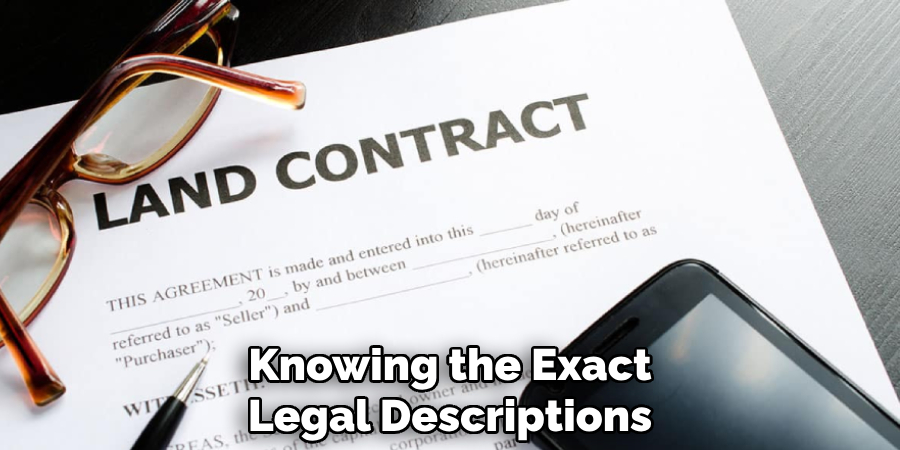Dealing with neighbors who frequently encroach upon your property can be a frustrating and challenging experience. Whether it’s accidental or intentional, these intrusions can infringe upon your privacy and disrupt the peaceful enjoyment of your home.

In this guide on how to keep neighbors off my property, we will explore a range of strategies and legal measures you can implement to clearly define your property boundaries and encourage your neighbors to respect them.
From erecting physical barriers to fostering open communication, there are numerous solutions that can help maintain harmony while ensuring your property remains exclusively yours.
What is Property Encroachment?
Property encroachment occurs when a neighbor extends their property or activities onto your land without permission.
This can take many forms, such as building a fence that crosses the property line, placing a shed or other structure partially on your property, or even allowing plants or trees to grow into your space.
Encroachments can also include less tangible invasions, such as a surveillance camera pointed directly into your yard or unauthorized parking. These actions can lead to disputes and legal complications, especially if left unchecked for an extended period.
Understanding what constitutes property encroachment is the first step toward addressing and resolving such issues, ensuring that your property rights are upheld and your home remains a sanctuary.
Why Do Neighbors Encroach on My Property?
There are various reasons why neighbors may encroach upon your property. Some may not be aware that they are overstepping their boundaries, while others may do so deliberately for their own gain.
For example, a neighbor may extend their fence to gain more yard space or plant trees to block an unwanted view from your property.
In some cases, encroachment can also occur due to negligence or lack of proper maintenance of shared areas such as fences or retaining walls. Regardless of the reason, it’s essential to approach the situation calmly and find a mutually beneficial resolution.

Needed Materials
- A Property Survey or Plat Map Showing the Boundaries of Your Land.
- Property Deed or Title to Your Land.
- Camera or Phone to Document Any Encroachment.
- Measuring Tape and Stakes if You Plan on Erecting Physical Barriers.
8 Simple Step-by-step Guidelines on How to Keep Neighbors Off My Property
Step 1: Communicate with Your Neighbor
The first and often most effective step in addressing property encroachment is to communicate directly with your neighbor.
Approach the conversation calmly and politely, ensuring that it does not escalate into an argument. Start by explaining your concerns and presenting any evidence of the encroachment, such as photos or survey documents.
It’s possible that your neighbor is unaware of the property boundaries or the impact of their actions.
By having an open dialogue, you can often reach a mutual understanding and agreement on how to rectify the situation. Clear and respectful communication can go a long way in maintaining a positive relationship and preventing future disputes.
Step 2: Understand Local Property Laws and Regulations
Familiarizing yourself with local property laws and regulations is critical when addressing property encroachment. Each city, county, or state may have specific statutes and ordinances that govern property boundaries and trespassing.
Start by researching your local government’s website or contacting the relevant authorities, such as the county assessor’s office or the land surveyor’s office, to gather information.
Knowing the exact legal descriptions and any applicable zoning laws will empower you to take appropriate action if necessary.

Additionally, understanding these laws will help you navigate the legal process if you need to escalate the matter.
Property laws can dictate the types of barriers you are allowed to erect, the process for resolving boundary disputes, and the steps for filing a formal complaint.
Familiarity with these regulations ensures that any action you take is within your legal rights, thereby avoiding potential legal repercussions and further complications.
Step 3: Gather Evidence
Document any encroachments thoroughly by taking photos or videos of the disputed area. Having visual evidence will prove helpful when communicating with your neighbor and can also serve as evidence should the matter go to court.
Make sure to accurately document the extent of the encroachment, including any structures, plants, or objects that have crossed onto your property. It’s also a good idea to take measurements and note down any damage caused by the encroachment.
If possible, obtain a property survey or plat map from your local government to support your claim. These documents show the precise location of your property boundaries and can serve as strong evidence in any legal proceedings.
Step 4: Consider Mediation
If communication with your neighbor does not lead to a resolution, you may wish to consider mediation. A mediator is an impartial third party who can facilitate discussions between both parties and help find a mutually agreeable solution.
This approach allows for open communication while reducing potential tensions and avoiding court proceedings.
You can seek out professional mediators through community organizations, churches, or local government agencies. Alternatively, you could try to find a neutral third party, such as another neighbor or friend, who is trusted by both parties to mediate the discussion.
Step 5: Erect Physical Barriers
If all else fails and your neighbor continues to encroach upon your property, you may need to take physical measures to protect your land. This can include erecting fences, walls, or other barriers along the property line.
Before doing so, check local regulations and ensure that you have clear evidence of the encroachment.
It’s essential to note that physical barriers should only be used as a last resort and can potentially escalate tensions between neighbors. Consider discussing your plans with your neighbor and getting their consent before taking any physical action.
Step 6: File a Formal Complaint
If the encroachment persists despite your efforts to resolve the issue, you may need to file a formal complaint with the appropriate authorities. This could include contacting local law enforcement or seeking legal advice from an attorney.
Having thorough documentation and evidence will be crucial in this step.
Filing a formal complaint can lead to legal proceedings, so it’s essential to make sure that you have exhausted all other options before taking this step.
Step 7: Seek Legal Assistance
In some cases, legal action may be the only option to resolve a property encroachment issue. If you are considering this route, it’s crucial to consult with an experienced real estate attorney who can advise you on your rights and options.
They can also assist in negotiating with your neighbor or representing you in court if necessary.

You should be aware that legal action can be costly and time-consuming, so it’s essential to carefully consider all other options before pursuing this route.
Step 8: Maintain Communication and Boundary Markers
Even after resolving the encroachment issue, it’s essential to maintain open communication with your neighbor and keep up-to-date boundary markers. This will help prevent any future misunderstandings or disputes regarding property boundaries.
It’s also advisable to periodically check your property boundaries and promptly address any potential encroachments. This will help ensure that your property remains protected and your relationship with your neighbor stays amicable.
By following these steps on how to keep neighbors off my property and approaching the issue calmly and respectfully, you can work towards resolving a property encroachment matter without causing undue stress or strain on your relationship with your neighbor.
Frequently Asked Questions
Q: What is Property Encroachment?
A: Property encroachment occurs when a neighbor’s land, building, or other structure crosses onto your property without your permission. It can also happen when a neighbor undertakes activities on their property that cause damage or interfere with the use of your land.
Q: What Steps Can I Take to Resolve a Property Encroachment Issue?
A: The first step is to try to communicate with your neighbor calmly and respectfully. If this does not lead to a resolution, you may need to gather evidence, consider mediation, erect physical barriers, file a formal complaint, seek legal assistance, or maintain open communication with your neighbor.

Each situation is unique, and the steps you take will depend on the severity of the encroachment and your local laws and regulations.
Q: What Legal Actions Can I Take Against Property Encroachment?
A: Depending on the severity of the encroachment, you may be able to file a trespassing or nuisance complaint with law enforcement.
You could also seek legal advice from an attorney who specializes in real estate matters to explore other options, such as filing a civil lawsuit for damages or seeking an injunction to stop further encroachment. It’s essential to carefully consider all possible legal actions before pursuing this route.
Conclusion
Dealing with property encroachment requires a strategic and thoughtful approach to ensure an amicable and effective resolution.
By maintaining open and respectful communication with your neighbor, documenting the encroachment thoroughly, and exploring mediation options, you can often resolve issues without escalating tensions.
Establishing physical barriers and seeking legal assistance should be considered as a last resort only when other avenues have been exhausted. Remember, the goal is to protect your property rights while preserving a healthy relationship with your neighbor.
By following the appropriate steps on how to keep neighbors off my property and staying informed about your legal options, you can address property encroachment in a manner that is both assertive and considerate.
About
Safety Fic is a distinguished figure in the world of Diy design, with a decade of expertise creating innovative and sustainable Diy solutions. His professional focus lies in merging traditional craftsmanship with modern manufacturing techniques, fostering designs that are both practical and environmentally conscious. As the author of diy, Safety Fic delves into the art and science of Safety Fic-making, inspiring artisans and industry professionals alike.
Education RMIT University
(Melbourne, Australia) Associate Degree in Design (Safety Fic) Focus on sustainable design, industry-driven projects, and practical craftsmanship. Gained hands-on experience with traditional and digital manufacturing tools, such as CAD and CNC software.
Nottingham Trent University
(United Kingdom) Bachelor’s in diyfastly.com and Product Design (Honors) Specialized in product design with a focus on blending creativity with production techniques. Participated in industry projects, working with companies like John Lewis and Vitsoe to gain real-world insights.
Publications and Impact
In diy, Safety Fic his insights on indoor design processes, materials, and strategies for efficient production. His writing bridges the gap between artisan knowledge and modern industry needs, making it a must-read for both budding designers and seasoned professionals.
